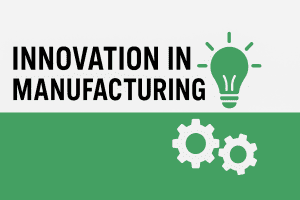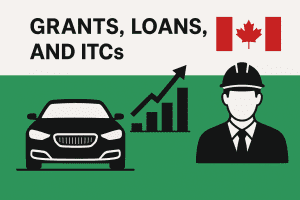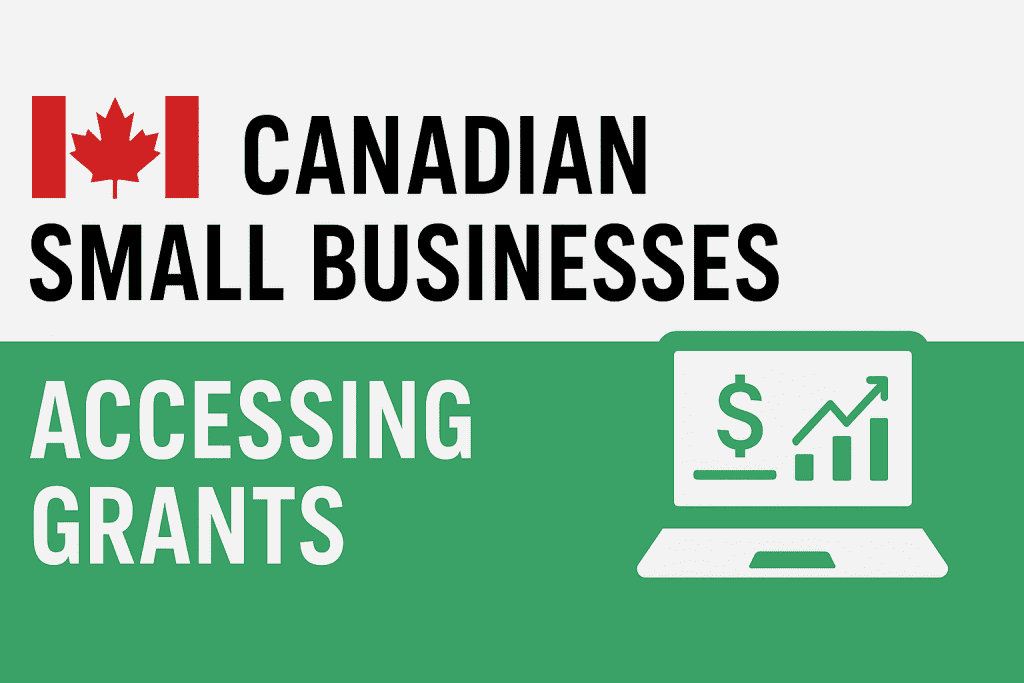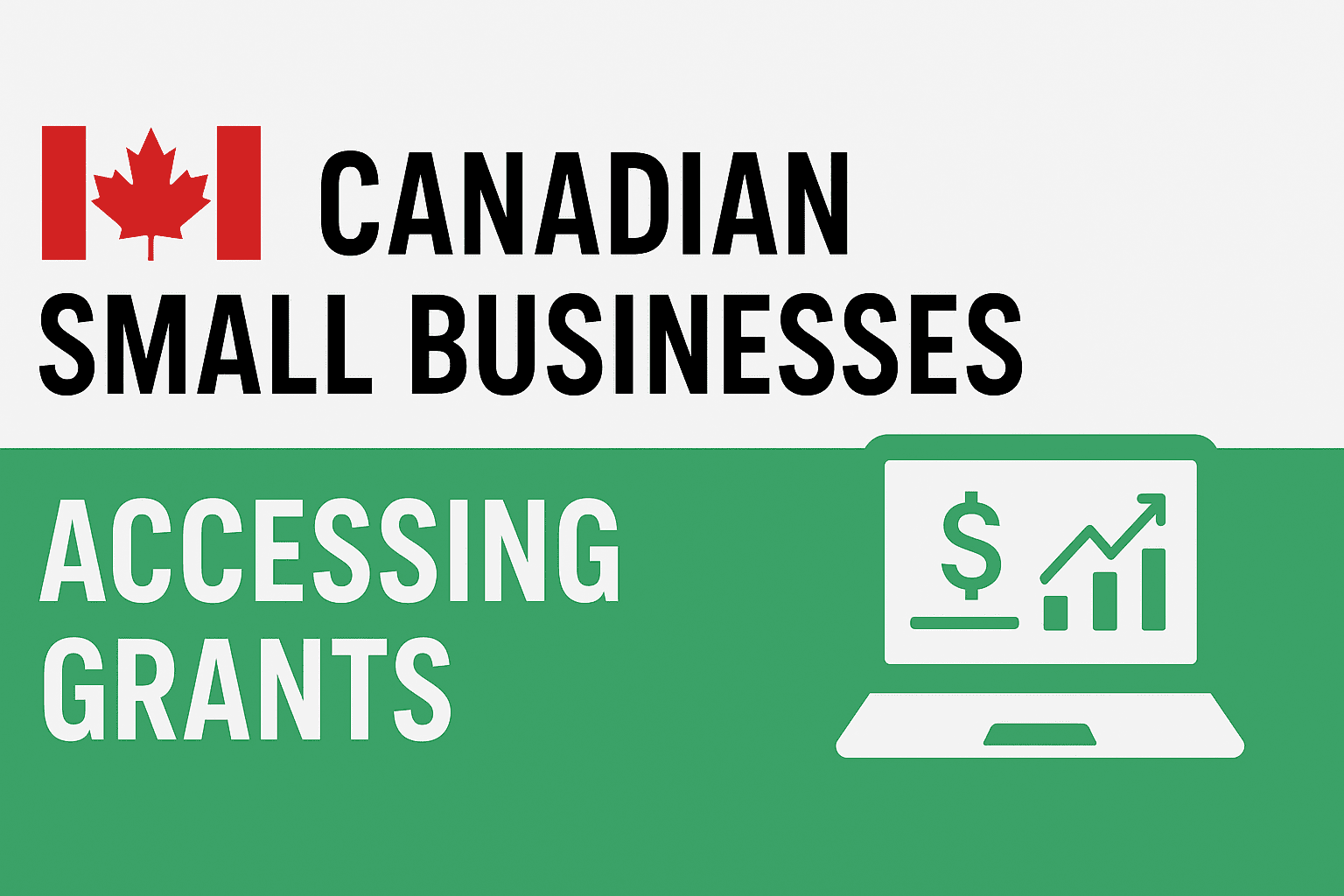Key Takeaways
The Canadian government offers dozens of business grant programs providing non-repayable funding
Small and medium enterprises (SMEs) with fewer than 500 employees can access federal programs like IRAP and CanExport
Many grants require businesses to be incorporated with proven revenue and specific project criteria
Application success rates improve significantly with proper preparation, clear business plans, and matching your project to grant objectives
Overview of Canada Business Grants
The Canadian government distributed over $4 billion in business grants and innovation incentives in 2024, yet many small businesses remain unaware of these funding opportunities. Canada’s business grants represent a diverse ecosystem of government-sponsored financial assistance programs designed to help companies start, expand, innovate, and compete globally.
Unlike traditional loans or investment capital, business grants are non-repayable financial contributions from government agencies. This means qualifying businesses receive funding without the obligation to pay back the money, making grants an attractive alternative to debt financing or equity dilution. However, most grants come with specific requirements and must be used for approved purposes outlined in the grant agreement.
The government of Canada has several key objectives behind these grant programs. Primary goals include stimulating job creation, fostering innovation and research, supporting export development, promoting economic recovery, and ensuring equitable regional development across all provinces and territories. Recent emphasis has focused on digital transformation, clean technology adoption, and supporting underrepresented entrepreneurs including women, Indigenous peoples, and minority business owners.
The current economic landscape in 2025 has created increased grant availability as governments respond to American tariffs, high inflation, supply chain disruptions, and the ongoing need for business modernization. Many businesses are leveraging these programs as “growth multipliers” to accelerate expansion plans that might otherwise be delayed due to cash flow constraints.
Various types of Canadian businesses qualify for government grants, though eligibility criteria vary significantly between programs. Generally, small businesses and SMEs with fewer than 500 existing employees represent the primary target demographic. Most programs require businesses to be incorporated for a minimum period, typically 2-3 years, with demonstrated revenue and clear growth plans.
Federal Government Grant Programs
The federal government serves as the cornerstone of grant funding in Canada, operating hundreds of programs across different departments and agencies. Federal grants typically offer larger funding amounts than provincial programs and maintain consistent eligibility criteria nationwide, making them accessible to Canadian SMEs regardless of location.
Total federal payment for business grants and innovation incentives exceeded $4 billion in 2024, distributed through various departments including Innovation, Science and Economic Development Canada (ISED), the National Research Council of Canada (NRC), and Export Development Canada (EDC). These programs support everything from early-stage research to international market expansion.
Innovation and Research Grants
The Industrial Research Assistance Program (IRAP), administered by the National Research Council, stands as one of Canada’s premier funding programs for technology-driven small businesses. IRAP provides funding up to $10 million for research and development projects, covering up to 80% of eligible costs for qualifying SMEs.
IRAP targets businesses developing innovative products, services, or processes with strong commercial potential. The program particularly supports clean technology development, artificial intelligence applications, and advanced manufacturing initiatives. To qualify, businesses must demonstrate technical merit, have formal R&D pathways, and employ fewer than 500 people. Application deadlines occur year-round as IRAP operates on a continuous intake basis.
Next Generation Manufacturing Canada (NGen) offers collaborative funding for advanced manufacturing projects that involve partnerships between companies, research institutions, and other organizations. Projects can receive up to $5.5 million in funding, depending on the program. NGen particularly supports initiatives in automotive, clean technology, and digital manufacturing.

Innovative Solutions Canada (ISC) operates as a procurement program that provides government contracts to businesses developing innovative solutions for federal departments. Rather than traditional grants, ISC offers contracts for proof-of-concept projects and prototype development.
Export Development Grants
The CanExport SMEs program enables small and medium businesses to explore new international markets by providing funding between $10,000 and $50,000 per approved project. This program covers eligible expenses including marketing activities, trade missions, regulatory compliance costs, and other resources necessary for successful market entry.
CanExport SMEs focuses on businesses ready to expand internationally but needing financial support to overcome initial barriers. Eligible costs include market research, trade show participation, product certification, and professional services required for export development. The program operates on fixed application deadlines throughout the year, typically offering an annual intake period from March to May.
CanExport Innovation supports international research and development partnership formation by funding. Projects can receive up to $75,000, with funding covering travel, product certification, IP protection, and other project-related expenses that facilitate international partnership development.
Creative Export Canada specifically targets cultural and creative industries seeking to expand into international markets. This specialized program recognizes the unique challenges faced by creative businesses and provides tailored support for export activities including digital marketing, international showcasing, and market development initiatives.
The EDC Trade Ready Program offers training and capacity-building support to help businesses develop export readiness. While not providing direct funding, this program prepares companies for successful grant applications and international expansion by addressing common knowledge gaps and operational challenges.
Workforce Development Grants
The Canada Job Grant operates through provincial delivery but maintains federal funding standards across all provinces and territories. This program provides third-party training funding to help businesses upskill new and existing employees. Employers typically contribute one-third of training costs while government covers the remaining two-thirds, up to maximum amounts that vary by province.
Canada Summer Jobs provides wage subsidies for hiring youth aged 15-30 during summer months, with particular emphasis on creating opportunities for students and recent graduates. Employers can receive up to 50% wage subsidies (100% for non-profits) for positions that provide valuable work experience and skill development opportunities.
Various federal departments operate hiring grants for interns and recent graduates, including programs specifically designed to support first nations, aboriginal entrepreneurs, and other underrepresented groups. These initiatives often combine wage subsidies with mentorship and professional development components.
The Indigenous Skills and Employment Training Program provides specialized workforce development funding for Indigenous communities and businesses. This program recognizes unique challenges and opportunities within Indigenous economies and offers flexible funding arrangements to support culturally appropriate training and employment initiatives.
Agricultural and Food Industry Grants
The Sustainable Canadian Agricultural Partnership (SCAP) represents a five-year agreement running through 2028 that provides comprehensive support for agricultural innovation, sustainability, and competitiveness. SCAP funding supports everything from on-farm technology adoption to food processing modernization and export market development.
The AgriScience Program specifically targets agriculture R&D projects that develop new products, processes, or services with commercial potential. Projects can receive up to $5 million in non-repayable contributions.
Regional agricultural development funds operate in specific geographic areas to address local challenges and opportunities. These programs often combine federal and provincial funding to support agricultural diversification, value-added processing, and rural economic development activities.
Provincial Business Grant Programs
Provincial governments complement federal funding programs by offering grants tailored to regional economic development priorities and local business needs. These programs often provide faster application processing and more flexible eligibility criteria than federal grants, making them particularly attractive to small business owners seeking quick access to funding.
Provincial grant programs typically focus on supporting businesses within their jurisdictions while encouraging interprovincial trade and collaboration. Many provinces have increased their grant funding in response to economic challenges and opportunities specific to their regions, creating a competitive landscape that benefits Canadian businesses across all sectors.
Ontario Public Funding
Ontario operates several major funding programs designed to support business scale up and capital investments across diverse industries.

Ontario’s Automotive Modernization Program (O-AMP) offers specialized support for automotive industry transformation, providing funding for efficiency improvements and technology adoption. This program reflects Ontario’s strategic focus on maintaining its position as a global automotive hub.
The Critical Minerals Innovation Fund (CMIF) provides funding for critical minerals-sector projects in certain priority areas like battery supply chain and mineral recovery.
The Regional Development Program oversees both the Southwestern Ontario Development Fund (SWODF) and Eastern Ontario Development Fund (EODF). While these funds typically administer loans, in special cases, applicants can receive grant contributions.
Regional eligibility requirements vary across Ontario programs, with some targeting specific geographic areas while others maintain province-wide availability. Funding caps vary, and most programs require businesses to demonstrate job creation and economic impact.
Other Provincial Programs
British Columbia operates several grant programs such as the B.C. Employer Training Grant (ETG), which offers British Columbian employers funding for workforce skills training.
Alberta’s Manufacturing Productivity Grant and Innovation Employment Grant target manufacturing and technology adoption respectively. These programs reflect Alberta’s economic diversification priorities as the province transitions from traditional energy dependence toward a more balanced economy including technology, manufacturing, and services.
Atlantic Canada benefits from specialized support through the Atlantic Canada Opportunities Agency (ACOA), which provides funding specifically designed to address the unique challenges and opportunities of maritime economies. ACOA programs support everything from tourism development to technology commercialization and export market development.
Saskatchewan and Manitoba operate regional development programs that reflect their agricultural and resource-based economies while supporting economic diversification. These programs often combine grants with loan guarantees and other financial instruments to provide comprehensive business support.
Grant Application Process and Requirements
Successfully securing Canadian business grants requires navigating complex eligibility standards and detailed application protocols. The application process typically spans several months from initial research to final approval, with successful applicants investing significant time and effort in proposal development and documentation preparation.
Most grant programs follow similar application processes despite varying specific requirements. Understanding these common elements helps businesses approach multiple programs efficiently while maximizing their chances of success across different funding opportunities.
Eligibility Criteria
Business incorporation requirements form the foundation of most grant eligibility criteria. Federal and provincial programs typically require businesses to be incorporated for a minimum period, usually 2-3 years, with some programs accepting newer companies under specific circumstances such as spinoffs from established organizations or businesses with experienced management teams.
Revenue thresholds represent another critical eligibility factor, with many programs requiring annual revenue of $100,000 or higher to demonstrate business viability and growth potential. Some programs set upper revenue limits to focus on small business support, while others establish minimum thresholds to ensure applicants have sufficient operational capacity to execute funded projects successfully.
Employee count requirements vary significantly between programs, with some targeting very small businesses while others require substantial workforces. Major federal grants often require 15 or more existing employees, while provincial programs may accept smaller businesses. Most programs count full-time equivalent positions rather than total headcount when evaluating employment criteria.
Industry-specific criteria reflect government priorities and program objectives. Innovation grants typically require businesses to operate in technology, manufacturing, or research-intensive sectors, while export grants may focus on businesses with exportable products or services. Location requirements ensure grant funding supports intended geographic regions and communities.
Financial health documentation requirements include audited financial statements, tax returns, and credit checks to verify business stability and repayment capacity for programs with repayable components. Many programs require businesses to demonstrate positive cash flow and adequate working capital to complete proposed projects without risking operational continuity.
Required Documentation
Business registration and incorporation documents provide foundational verification of legal status, ownership structure, and operational history. Grant administrators require current corporate registry information, articles of incorporation, and any amendments or updates to corporate structure since initial registration.
Financial statements and tax returns for the last three years demonstrate business performance, growth trends, and financial stability. Most programs require audited or review engagement financial statements for larger businesses, while smaller companies may submit internally prepared statements accompanied by accountant-prepared tax returns.
Detailed project proposals form the heart of grant applications, requiring clear articulation of project objectives, methodologies, timelines, and expected outcomes. Successful proposals demonstrate strong alignment with grant program objectives while providing sufficient detail for technical and financial evaluation by review committees.
Market analysis and competitive landscape assessments support project viability by demonstrating market opportunity, competitive advantages, and realistic revenue projections. Grant reviewers evaluate whether proposed projects address genuine market needs and whether applicant businesses possess the capabilities necessary for successful execution.

Project budget breakdowns must provide detailed cost estimates for all project components, including personnel, equipment, materials, and other eligible expenses. Many programs require businesses to contribute matching funds, typically ranging from 25% to 75% of total project costs, demonstrating commitment and shared risk.
Application Best Practices
Researching grant fit before applying significantly improves success rates by ensuring strong alignment between project objectives and program priorities. Successful applicants invest time understanding program history, funding patterns, and review criteria rather than pursuing funding opportunities indiscriminately.
Creating compelling project narratives requires clear communication of project benefits, innovation elements, and economic impact. Grant reviewers evaluate hundreds of applications, making clarity, conciseness, and compelling storytelling essential for capturing attention and securing funding approval.
Building relationships with program officers and grant administrators provides valuable insights into application expectations and review processes. Many programs offer pre-application consultations or information sessions that help applicants understand evaluation criteria and optimize their proposals accordingly.
Timing applications with funding cycles and deadlines requires careful planning and project management. Most programs operate on annual cycles with fixed application deadlines, while others maintain continuous intake with regular review periods. Early application submission often improves review quality and demonstrates strong organizational capabilities.
Grant Management and Compliance
Post-award responsibilities begin immediately upon grant approval and continue throughout project execution and reporting periods. Grant recipients must maintain detailed records, meet reporting requirements, and comply with all program terms to avoid funding clawbacks or future eligibility restrictions.
Fund disbursement schedules vary between programs, with some providing upfront funding while others release payments based on milestone completion or expense reimbursement. Understanding disbursement timing helps businesses plan cash flow and ensure adequate working capital throughout project execution periods.
Milestone tracking and reporting requirements ensure grant funds achieve intended objectives while providing accountability to taxpayers funding these programs. Many grants require quarterly or semi-annual progress reports, financial statements, and outcome measurements that demonstrate project advancement toward stated goals.
Audit requirements and record-keeping obligations extend beyond project completion, with many programs maintaining audit rights for three to seven years after final reporting. Grant recipients must maintain comprehensive documentation including invoices, receipts, timesheets, and other records supporting all claimed expenses and activities.
Tax implications of grant funding vary depending on program structure and business circumstances. While most grants represent taxable income, certain programs may qualify for favorable tax treatment. Recipients should consult with accounting professionals to understand specific tax obligations and optimize their overall tax position.
Consequences of non-compliance range from funding reduction to complete clawback, depending on the severity and nature of violations. More serious breaches may result in exclusion from future grant programs, making compliance a critical business priority that extends beyond individual projects.
Alternative Funding Options
Government loans and loan guarantees provide alternative funding for businesses that don’t qualify for grants or need larger funding amounts than grants typically provide. Programs such as the Business Development Bank of Canada (BDC) and regional development agencies offer favorable lending terms that complement grant funding or serve as standalone financing solutions.
Private foundation grants and corporate giving programs represent another funding avenue, particularly for businesses with social impact components or community development focus. These programs often have different eligibility criteria and application processes than government grants, potentially serving businesses that don’t qualify for public funding.
Crowdfunding and community-based funding initiatives have gained popularity as alternative financing methods, particularly for consumer-focused businesses with strong community connections. These platforms allow businesses to validate market demand while raising capital, though they require significant marketing effort and public engagement.
Tax credit programs serve as alternatives to direct grants by reducing tax liabilities rather than providing cash payments. Beyond SR&ED, various provincial and federal tax credits support specific activities such as apprenticeship training, film production, and clean energy adoption.
When to consider venture capital or private investment instead of grants depends on business growth stage, funding requirements, and willingness to accept equity dilution. High-growth technology companies may find private investment more suitable for rapid scaling, while established businesses seeking specific project funding may prefer grants.
FAQ
How long does it typically take to receive grant funding after application approval in Canada?
Funding timelines vary significantly between programs, but most grants disburse funds within 6-12 weeks after approval. Some programs provide immediate funding upon contract execution, while others release payments based on milestone completion or expense reimbursement. Complex innovation grants may require additional documentation before initial disbursement, potentially extending timelines to 3-4 months.
Can a business apply for multiple government grants simultaneously, and are there any restrictions?
Yes, businesses can apply for multiple grants simultaneously, and many successful companies maintain active applications across several programs. There is usually not a problem if each grant is used for a distinct set of costs. However, if multiple grants are used to fund the same costs, this is known as “stacking.” Most programs have a stacking limit, often 75%, and may prohibit like funds from being used together (e.g., you may not use more than one provincial fund for the same costs).
What happens if my business doesn’t meet the grant milestones or project objectives after receiving funding?
Failure to meet grant milestones can result in funding suspension, partial repayment requirements, or clawbacks depending on the severity and circumstances. Most programs work with recipients to address challenges and modify timelines when reasonable, but consistent non-performance may lead to reduction or complete cancellation of funding, and in some cases, exclusion from future funding opportunities. Maintaining open communication with program officers often helps resolve issues before they become serious problems.
How do I avoid grant scams and verify that a funding opportunity is legitimate?
Legitimate grants never require upfront fees or payments to apply. Verify programs through official government websites such as ISED’s Business Benefits Finder or contact program offices directly. Be suspicious of unsolicited grant offers, guaranteed approvals, or pressure to act quickly. Most scams involve fake application fees or requests for banking information. When in doubt, consult with business advisors or contact the relevant government department to confirm program legitimacy.



